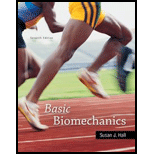
Basic Biomechanics
7th Edition
ISBN: 9780073522760
Author: Susan J Hall
Publisher: McGraw-Hill Education
expand_more
expand_more
format_list_bulleted
Question
Chapter 1, Problem 8AP
(a)
Summary Introduction
To find: Total distance covered by the person J. in noontime run.
(b)
Summary Introduction
To find: Total time required by the person J to complete the noontime run.
Expert Solution & Answer
Want to see the full answer?
Check out a sample textbook solution
Chapter 1 Solutions
Basic Biomechanics
Ch. 1 - Write a brief discussion about how knowledge of...Ch. 1 - Prob. 4IPCh. 1 - Write a summary list of the problem-solving steps...Ch. 1 - Prob. 6IPCh. 1 - Step by step, show how to arrive at a solution to...Ch. 1 - Solve for x in each of the equations below. Refer...Ch. 1 - Two schoolchildren race across a playground for a...Ch. 1 - A 0.5 kg ball is kicked with a force of 40 N. What...Ch. 1 - When attempting to balance your checkbook, you...Ch. 1 - Prob. 3AP
Ch. 1 - Wendell invests 10,000 in a stock portfolio made...Ch. 1 - The hypotenuse of right triangle ABC (shown here)...Ch. 1 - In triangle DEF, side E is 4 cm long and side F is...Ch. 1 - An orienteer runs 300 m north and then 400 m to...Ch. 1 - Prob. 8APCh. 1 - Prob. 9APCh. 1 - A sailboat heads north at 3 m/s for 1 hour and...
Knowledge Booster
Recommended textbooks for you
 Principles Of Radiographic Imaging: An Art And A ...Health & NutritionISBN:9781337711067Author:Richard R. Carlton, Arlene M. Adler, Vesna BalacPublisher:Cengage Learning
Principles Of Radiographic Imaging: An Art And A ...Health & NutritionISBN:9781337711067Author:Richard R. Carlton, Arlene M. Adler, Vesna BalacPublisher:Cengage Learning Human Physiology: From Cells to Systems (MindTap ...BiologyISBN:9781285866932Author:Lauralee SherwoodPublisher:Cengage Learning
Human Physiology: From Cells to Systems (MindTap ...BiologyISBN:9781285866932Author:Lauralee SherwoodPublisher:Cengage Learning- Case Studies In Health Information ManagementBiologyISBN:9781337676908Author:SCHNERINGPublisher:Cengage

Principles Of Radiographic Imaging: An Art And A ...
Health & Nutrition
ISBN:9781337711067
Author:Richard R. Carlton, Arlene M. Adler, Vesna Balac
Publisher:Cengage Learning


Human Physiology: From Cells to Systems (MindTap ...
Biology
ISBN:9781285866932
Author:Lauralee Sherwood
Publisher:Cengage Learning


Case Studies In Health Information Management
Biology
ISBN:9781337676908
Author:SCHNERING
Publisher:Cengage
